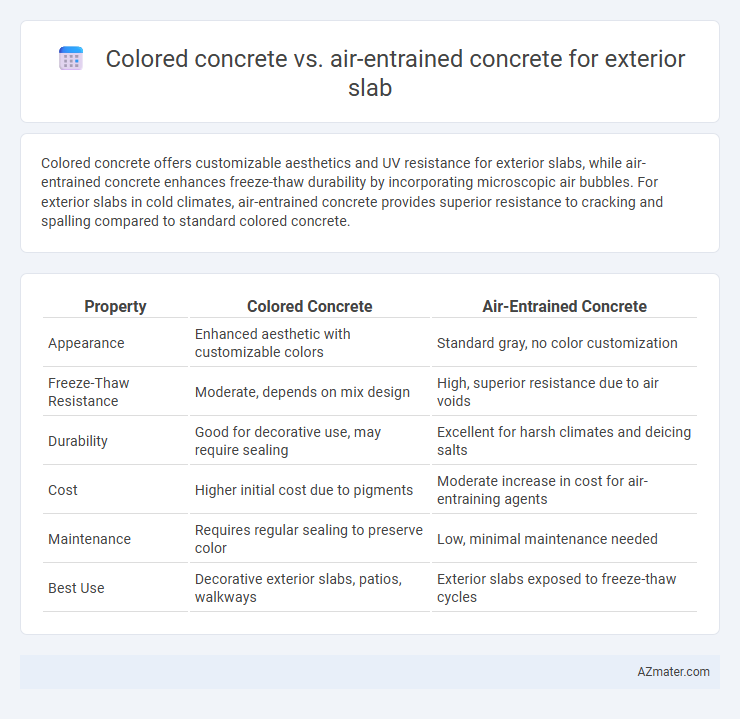Colored concrete offers customizable aesthetics and UV resistance for exterior slabs, while air-entrained concrete enhances freeze-thaw durability by incorporating microscopic air bubbles. For exterior slabs in cold climates, air-entrained concrete provides superior resistance to cracking and spalling compared to standard colored concrete.
Table of Comparison
| Property | Colored Concrete | Air-Entrained Concrete |
|---|---|---|
| Appearance | Enhanced aesthetic with customizable colors | Standard gray, no color customization |
| Freeze-Thaw Resistance | Moderate, depends on mix design | High, superior resistance due to air voids |
| Durability | Good for decorative use, may require sealing | Excellent for harsh climates and deicing salts |
| Cost | Higher initial cost due to pigments | Moderate increase in cost for air-entraining agents |
| Maintenance | Requires regular sealing to preserve color | Low, minimal maintenance needed |
| Best Use | Decorative exterior slabs, patios, walkways | Exterior slabs exposed to freeze-thaw cycles |
Introduction to Concrete Types for Exterior Slabs
Colored concrete enhances aesthetic appeal through integrated pigments, offering customizable hues and patterns ideal for decorative exterior slabs. Air-entrained concrete improves durability by incorporating microscopic air bubbles that increase resistance to freeze-thaw cycles and deicing chemicals, making it suitable for harsh weather conditions on exterior surfaces. Both types address specific functional and visual requirements, with colored concrete prioritizing design and air-entrained concrete focusing on longevity and structural integrity.
What is Colored Concrete?
Colored concrete is a type of concrete that incorporates pigments to achieve a wide range of vibrant or subtle hues, enhancing aesthetic appeal for exterior slabs. This concrete allows for customization in color while maintaining structural integrity, making it ideal for decorative finishes and design-focused projects. Unlike air-entrained concrete, which focuses on improving freeze-thaw durability by incorporating microscopic air bubbles, colored concrete prioritizes visual impact without significantly altering the material's physical properties.
What is Air-entrained Concrete?
Air-entrained concrete contains microscopic air bubbles introduced using air-entraining agents, which enhance durability and resistance to freeze-thaw cycles in exterior slabs. Colored concrete, on the other hand, incorporates pigments for aesthetic purposes but does not inherently improve resistance to environmental stress. Air-entrained concrete is essential for exterior slabs in cold climates as it prevents cracking and scaling caused by moisture expansion during freezing.
Key Benefits of Colored Concrete for Outdoor Spaces
Colored concrete enhances exterior slabs by providing vibrant, customizable aesthetics that elevate outdoor spaces' visual appeal and complement landscaping. Its UV-resistant pigments ensure long-lasting color retention, reducing maintenance needs compared to traditional methods. Unlike air-entrained concrete, which primarily improves freeze-thaw durability, colored concrete offers both functional strength and diverse design options for patios, walkways, and pool decks.
Key Benefits of Air-entrained Concrete in Exterior Applications
Air-entrained concrete contains microscopic air bubbles that significantly enhance freeze-thaw durability in exterior slabs, reducing surface scaling and cracking caused by cyclic weather conditions. This improved resistance to moisture penetration and de-icing chemicals extends the lifespan of pavements, driveways, and walkways exposed to harsh environments. Compared to colored concrete, air-entrained concrete offers superior structural integrity and long-term performance in climates with frequent temperature fluctuations.
Durability: Comparing Colored and Air-entrained Concrete
Colored concrete enhances exterior slab durability by integrating pigmentation that resists UV fading and surface weathering, maintaining aesthetic appeal over time. Air-entrained concrete improves freeze-thaw resistance in exterior slabs by incorporating microscopic air bubbles, reducing internal stress and minimizing cracking in cold climates. For long-term performance under harsh environmental conditions, air-entrained concrete offers superior durability, while colored concrete provides added value through aesthetic longevity.
Weather Resistance and Freeze-Thaw Performance
Colored concrete enhances aesthetic appeal while maintaining durability but may require sealants to improve its weather resistance and prevent surface wear in harsh climates. Air-entrained concrete incorporates microscopic air bubbles that significantly improve freeze-thaw resistance by relieving internal pressure caused by water expansion during freezing cycles. For exterior slabs exposed to freeze-thaw conditions, air-entrained concrete offers superior protection against cracking and scaling compared to standard colored concrete without air entrainment.
Aesthetic Choices: Design Flexibility and Visual Appeal
Colored concrete offers extensive design flexibility and vibrant visual appeal by incorporating pigments directly into the mix, allowing for customized hues and patterns ideal for exterior slabs. Air-entrained concrete primarily enhances durability and freeze-thaw resistance but provides minimal aesthetic variation beyond standard gray tones. Selecting colored concrete enables tailored exterior slab designs that enhance curb appeal and complement architectural styles, whereas air-entrained concrete focuses on functional performance in harsh climates.
Maintenance Requirements: Colored vs Air-entrained Concrete
Colored concrete requires periodic sealing to maintain its vibrant appearance and prevent fading from UV exposure, while air-entrained concrete primarily demands attention to freeze-thaw cycle protection without specific aesthetic maintenance. Air-entrained concrete's microscopic air bubbles enhance durability in cold climates, reducing cracking and spalling, thus lowering long-term repair needs compared to standard concrete. Maintenance for colored concrete often involves cleaning and resealing every few years, whereas air-entrained concrete benefits most from proper drainage and surface protection to maximize lifespan.
Cost Analysis and Practical Considerations
Colored concrete for exterior slabs offers aesthetic versatility but typically incurs higher initial costs due to pigments and specialized mixing, while air-entrained concrete, designed to improve freeze-thaw durability, may have a slightly higher material cost but reduces maintenance expenses over time. Practical considerations include colored concrete's susceptibility to fading and staining, requiring periodic sealing, whereas air-entrained concrete enhances resistance to cracking and scaling in cold climates, extending slab lifespan. Cost analysis reveals that colored concrete's visual appeal adds value mainly for design-focused projects, while air-entrained concrete delivers long-term economic benefits through durability in harsh weather conditions.

Infographic: Colored concrete vs Air-entrained concrete for Exterior Slab
 azmater.com
azmater.com